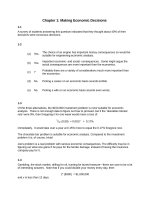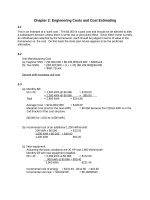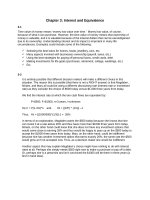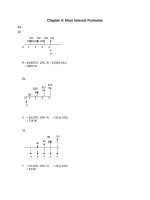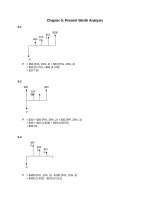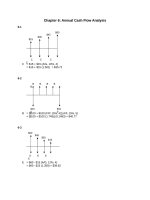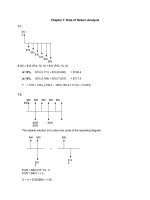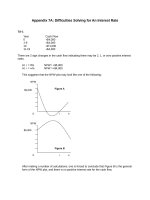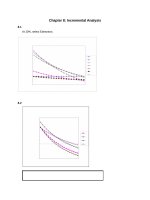Solution manual engineering mechanics dynamics 12th edition chapter 12
Bạn đang xem bản rút gọn của tài liệu. Xem và tải ngay bản đầy đủ của tài liệu tại đây (15.06 MB, 176 trang )
91962_01_s12-p0001-0176
6/8/09
8:05 AM
Page 1
© 2010 Pearson Education, Inc., Upper Saddle River, NJ. All rights reserved. This material is protected under all copyright laws as they currently
exist. No portion of this material may be reproduced, in any form or by any means, without permission in writing from the publisher.
•12–1. A car starts from rest and with constant
acceleration achieves a velocity of 15 m>s when it travels a
distance of 200 m. Determine the acceleration of the car
and the time required.
Kinematics:
v0 = 0, v = 15 m>s, s0 = 0, and s = 200 m.
+ B
A:
v2 = v0 2 + 2ac(s - s0)
152 = 02 + 2ac(200 - 0)
ac = 0.5625 m>s2
+ B
A:
Ans.
v = v0 + act
15 = 0 + 0.5625t
t = 26.7 s
Ans.
12–2. A train starts from rest at a station and travels with
a constant acceleration of 1 m>s2. Determine the velocity of
the train when t = 30 s and the distance traveled during
this time.
Kinematics:
ac = 1 m>s2, v0 = 0, s0 = 0, and t = 30 s.
+ B
A:
v = v0 + act
Ans.
= 0 + 1(30) = 30 m>s
+ B
A:
s = s0 + v0t +
= 0 + 0 +
1 2
at
2 c
1
(1) A 302 B
2
= 450 m
Ans.
1
91962_01_s12-p0001-0176
6/8/09
8:05 AM
Page 2
© 2010 Pearson Education, Inc., Upper Saddle River, NJ. All rights reserved. This material is protected under all copyright laws as they currently
exist. No portion of this material may be reproduced, in any form or by any means, without permission in writing from the publisher.
12–3. An elevator descends from rest with an acceleration
of 5 ft>s2 until it achieves a velocity of 15 ft>s. Determine the
time required and the distance traveled.
Kinematics:
ac = 5 ft>s2, v0 = 0, v = 15 ft>s, and s0 = 0.
A+TB
v = v0 + act
15 = 0 + 5t
t = 3s
A+TB
Ans.
v2 = v0 2 + 2ac(s - s0)
152 = 02 + 2(5)(s - 0)
s = 22.5 ft
Ans.
*12–4. A car is traveling at 15 m>s, when the traffic light
50 m ahead turns yellow. Determine the required constant
deceleration of the car and the time needed to stop the car
at the light.
Kinematics:
v0 = 0, s0 = 0, s = 50 m and v0 = 15 m>s.
+ B
A:
v2 = v0 2 + 2ac(s - s0)
0 = 152 + 2ac(50 - 0)
ac = -2.25 m>s2 = 2.25 m>s2 ;
+ B
A:
Ans.
v = v0 + act
0 = 15 + (-2.25)t
t = 6.67 s
Ans.
2
91962_01_s12-p0001-0176
6/8/09
8:05 AM
Page 3
© 2010 Pearson Education, Inc., Upper Saddle River, NJ. All rights reserved. This material is protected under all copyright laws as they currently
exist. No portion of this material may be reproduced, in any form or by any means, without permission in writing from the publisher.
•12–5. A particle is moving along a straight line with the
acceleration a = (12t – 3t1/2) ft>s2, where t is in seconds.
Determine the velocity and the position of the particle as a
function of time. When t = 0, v = 0 and s = 15 ft.
Velocity:
+ B
A:
dv = a dt
t
v
dv =
L0
L0
A 12t - 3t1>2 B dt
vΗ0 = A 6t2 - 2t3>2 B 2
v
t
0
v = A 6t2 - 2t3>2 B ft>s
Ans.
Position: Using this result and the initial condition s = 15 ft at t = 0 s,
+ B
A:
ds = v dt
s
t
ds =
L15 ft
L0
A 6t2 - 2t3>2 B dt
sΗ15 ft = a 2t3 s
s = a 2t3 -
4 5>2 2 t
t b
5
0
4 5>2
t + 15 bft
5
Ans.
12–6. A ball is released from the bottom of an elevator
which is traveling upward with a velocity of 6 ft>s. If the ball
strikes the bottom of the elevator shaft in 3 s, determine the
height of the elevator from the bottom of the shaft at the
instant the ball is released. Also, find the velocity of the ball
when it strikes the bottom of the shaft.
Kinematics: When the ball is released, its velocity will be the same as the elevator at
the instant of release. Thus, v0 = 6 ft>s. Also, t = 3 s, s0 = 0, s = -h, and
ac = -32.2 ft>s2.
A+cB
s = s0 + v0t +
1
a t2
2 c
-h = 0 + 6(3) +
1
(-32.2) A 32 B
2
h = 127 ft
A+cB
Ans.
v = v0 + act
v = 6 + (-32.2)(3)
= -90.6 ft>s = 90.6 ft>s
Ans.
T
3
91962_01_s12-p0001-0176
6/8/09
8:05 AM
Page 4
© 2010 Pearson Education, Inc., Upper Saddle River, NJ. All rights reserved. This material is protected under all copyright laws as they currently
exist. No portion of this material may be reproduced, in any form or by any means, without permission in writing from the publisher.
12–7. A car has an initial speed of 25 m>s and a constant
deceleration of 3 m>s2. Determine the velocity of the car
when t = 4 s. What is the displacement of the car during the
4-s time interval? How much time is needed to stop the car?
v = v0 + act
Ans.
v = 25 + (-3)(4) = 13 m>s
¢s = s - s0 = v0 t +
1
a t2
2 c
¢s = s - 0 = 25(4) +
1
(-3)(4)2 = 76 m
2
Ans.
v = v0 + ac t
0 = 25 + (-3)(t)
t = 8.33 s
Ans.
*12–8. If a particle has an initial velocity of v0 = 12 ft>s to
the right, at s0 = 0, determine its position when t = 10 s, if
a = 2 ft>s2 to the left.
+ B
A:
s = s0 + v0 t +
1
a t2
2 c
= 0 + 12(10) +
1
( -2)(10)2
2
= 20 ft
Ans.
•12–9. The acceleration of a particle traveling along a
straight line is a = k>v, where k is a constant. If s = 0,
v = v0 when t = 0, determine the velocity of the particle as
a function of time t.
Velocity:
+ B
A:
dt =
dv
a
t
v
dt =
L0
t
L0
dv
k>v
Lv0
v
dt =
1
vdv
k
Lv0
t
1 2 2v
t2 =
v
2k v0
0
t =
1
A v2 - v0 2 B
2k
v = 22kt + v0 2
Ans.
4
91962_01_s12-p0001-0176
6/8/09
8:05 AM
Page 5
© 2010 Pearson Education, Inc., Upper Saddle River, NJ. All rights reserved. This material is protected under all copyright laws as they currently
exist. No portion of this material may be reproduced, in any form or by any means, without permission in writing from the publisher.
12–10. Car A starts from rest at t = 0 and travels along a
straight road with a constant acceleration of 6 ft>s2 until it
reaches a speed of 80 ft>s. Afterwards it maintains this
speed. Also, when t = 0, car B located 6000 ft down the
road is traveling towards A at a constant speed of 60 ft>s.
Determine the distance traveled by car A when they pass
each other.
60 ft/s
A
6000 ft
Distance Traveled: Time for car A to achives y = 80 ft>s can be obtained by
applying Eq. 12–4.
+ B
A:
y = y0 + ac t
80 = 0 + 6t
t = 13.33 s
The distance car A travels for this part of motion can be determined by applying
Eq. 12–6.
+ B
A:
y2 = y20 + 2ac (s - s0)
802 = 0 + 2(6)(s1 - 0)
s1 = 533.33 ft
For the second part of motion, car A travels with a constant velocity of y = 80 ft>s
and the distance traveled in t¿ = (t1 - 13.33) s (t1 is the total time) is
+ B
A:
s2 = yt¿ = 80(t1 - 13.33)
Car B travels in the opposite direction with a constant velocity of y = 60 ft>s and
the distance traveled in t1 is
+ B
A:
B
s3 = yt1 = 60t1
It is required that
s1 + s2 + s3 = 6000
533.33 + 80(t1 - 13.33) + 60t1 = 6000
t1 = 46.67 s
The distance traveled by car A is
sA = s1 + s2 = 533.33 + 80(46.67 - 13.33) = 3200 ft
Ans.
5
91962_01_s12-p0001-0176
6/8/09
8:05 AM
Page 6
© 2010 Pearson Education, Inc., Upper Saddle River, NJ. All rights reserved. This material is protected under all copyright laws as they currently
exist. No portion of this material may be reproduced, in any form or by any means, without permission in writing from the publisher.
12–11. A particle travels along a straight line with a
velocity v = (12 - 3t2) m>s, where t is in seconds. When
t = 1 s, the particle is located 10 m to the left of the origin.
Determine the acceleration when t = 4 s, the displacement
from t = 0 to t = 10 s, and the distance the particle travels
during this time period.
v = 12 - 3t2
(1)
dv
= -6t 2
= -24 m>s2
dt
t=4
a =
s
t
ds =
L-10
L1
t
v dt =
L1
Ans.
A 12 - 3t2 B dt
s + 10 = 12t - t3 - 11
s = 12t - t3 - 21
s| t = 0 = -21
s|t = 10 = -901
Ans.
¢s = -901 - ( -21) = -880 m
From Eq. (1):
v = 0 when t = 2s
s|t = 2 = 12(2) - (2)3 - 21 = -5
sT = (21 - 5) + (901 - 5) = 912 m
Ans.
6
91962_01_s12-p0001-0176
6/8/09
8:05 AM
Page 7
© 2010 Pearson Education, Inc., Upper Saddle River, NJ. All rights reserved. This material is protected under all copyright laws as they currently
exist. No portion of this material may be reproduced, in any form or by any means, without permission in writing from the publisher.
*12–12. A sphere is fired downwards into a medium with
an initial speed of 27 m>s. If it experiences a deceleration of
a = (-6t) m>s2, where t is in seconds, determine the
distance traveled before it stops.
Velocity: y0 = 27 m>s at t0 = 0 s. Applying Eq. 12–2, we have
A+TB
dy = adt
t
y
L27
dy =
L0
-6tdt
y = A 27 - 3t2 B m>s
[1]
At y = 0, from Eq.[1]
0 = 27 - 3t2
t = 3.00 s
Distance Traveled: s0 = 0 m at t0 = 0 s. Using the result y = 27 - 3t2 and applying
Eq. 12–1, we have
A+TB
ds = ydt
s
L0
t
ds =
L0
A 27 - 3t2 B dt
s = A 27t - t3 B m
[2]
At t = 3.00 s, from Eq. [2]
s = 27(3.00) - 3.003 = 54.0 m
Ans.
•12–13. A particle travels along a straight line such that in
2 s it moves from an initial position sA = +0.5 m to a
position sB = -1.5 m. Then in another 4 s it moves from sB
to sC = +2.5 m. Determine the particle’s average velocity
and average speed during the 6-s time interval.
¢s = (sC - sA) = 2 m
sT = (0.5 + 1.5 + 1.5 + 2.5) = 6 m
t = (2 + 4) = 6 s
vavg =
¢s
2
= = 0.333 m>s
t
6
(vsp)avg =
Ans.
sT
6
= = 1 m>s
t
6
Ans.
7
91962_01_s12-p0001-0176
6/8/09
8:05 AM
Page 8
© 2010 Pearson Education, Inc., Upper Saddle River, NJ. All rights reserved. This material is protected under all copyright laws as they currently
exist. No portion of this material may be reproduced, in any form or by any means, without permission in writing from the publisher.
12–14. A particle travels along a straight-line path such
that in 4 s it moves from an initial position sA = -8 m to a
position sB = +3 m. Then in another 5 s it moves from sB to
sC = -6 m. Determine the particle’s average velocity and
average speed during the 9-s time interval.
Average Velocity: The displacement from A to C is ¢s = sC - SA = -6 - (-8)
= 2 m.
yavg =
2
¢s
=
= 0.222 m>s
¢t
4 + 5
Ans.
Average Speed: The distances traveled from A to B and B to C are
sA : B = 8 + 3 = 11.0 m and sB : C = 3 + 6 = 9.00 m, respectively. Then, the
total distance traveled is sTot = sA : B + sB : C = 11.0 - 9.00 = 20.0 m.
A ysp B avg =
sTot
20.0
=
= 2.22 m>s
¢t
4 + 5
Ans.
v1 ϭ 44 ft/s
12–15. Tests reveal that a normal driver takes about 0.75 s
before he or she can react to a situation to avoid a collision.
It takes about 3 s for a driver having 0.1% alcohol in his
system to do the same. If such drivers are traveling on a
straight road at 30 mph (44 ft>s) and their cars can
decelerate at 2 ft>s2, determine the shortest stopping
distance d for each from the moment they see the
pedestrians. Moral: If you must drink, please don’t drive!
d
Stopping Distance: For normal driver, the car moves a distance of
d¿ = yt = 44(0.75) = 33.0 ft before he or she reacts and decelerates the car. The
stopping distance can be obtained using Eq. 12–6 with s0 = d¿ = 33.0 ft and y = 0.
+ B
A:
y2 = y20 + 2ac (s - s0)
02 = 442 + 2(-2)(d - 33.0)
d = 517 ft
Ans.
For a drunk driver, the car moves a distance of d¿ = yt = 44(3) = 132 ft before he
or she reacts and decelerates the car. The stopping distance can be obtained using
Eq. 12–6 with s0 = d¿ = 132 ft and y = 0.
+ B
A:
y2 = y20 + 2ac (s - s0)
02 = 442 + 2(-2)(d - 132)
d = 616 ft
Ans.
8
91962_01_s12-p0001-0176
6/8/09
8:05 AM
Page 9
© 2010 Pearson Education, Inc., Upper Saddle River, NJ. All rights reserved. This material is protected under all copyright laws as they currently
exist. No portion of this material may be reproduced, in any form or by any means, without permission in writing from the publisher.
*12–16. As a train accelerates uniformly it passes
successive kilometer marks while traveling at velocities of
2 m>s and then 10 m>s. Determine the train’s velocity when
it passes the next kilometer mark and the time it takes to
travel the 2-km distance.
Kinematics: For the first kilometer of the journey, v0 = 2 m>s, v = 10 m>s, s0 = 0,
and s = 1000 m. Thus,
+ B
A:
v2 = v0 2 + 2ac (s - s0)
102 = 22 + 2ac (1000 - 0)
ac = 0.048 m>s2
For the second
0.048 m>s2. Thus,
+ B
A:
kilometer,
v0 = 10 m>s,
s0 = 1000 m,
s = 2000 m,
and
v2 = v0 2 + 2ac (s - s0)
v2 = 102 + 2(0.048)(2000 - 1000)
v = 14 m>s
Ans.
For the whole journey, v0 = 2 m>s, v = 14 m>s, and 0.048 m>s2. Thus,
+ B
A:
v = v0 + act
14 = 2 + 0.048t
t = 250 s
Ans.
•12–17. A ball is thrown with an upward velocity of 5 m>s
from the top of a 10-m high building. One second later
another ball is thrown vertically from the ground with a
velocity of 10 m>s. Determine the height from the ground
where the two balls pass each other.
Kinematics: First, we will consider the motion of ball A with (vA)0 = 5 m>s,
(sA)0 = 0, sA = (h - 10) m, tA = t¿ , and ac = -9.81 m>s2. Thus,
A+cB
1
actA 2
2
sA = (sA)0 + (vA)0 tA +
h - 10 = 0 + 5t¿ +
1
(-9.81)(t¿)2
2
h = 5t¿ - 4.905(t¿)2 + 10
(1)
Motion of ball B is with (vB)0 = 10 m>s, (sB)0 = 0, sB = h, tB = t¿ - 1 and
ac = -9.81 m>s2. Thus,
A+cB
sB = (sB)0 + (vB)0 tB +
h = 0 + 10(t¿ - 1) +
1
ac tB 2
2
1
(-9.81)(t¿ - 1)2
2
h = 19.81t¿ - 4.905(t¿)2 - 14.905
(2)
Solving Eqs. (1) and (2) yields
h = 4.54 m
Ans.
t¿ = 1.68 m
9
91962_01_s12-p0001-0176
6/8/09
8:06 AM
Page 10
© 2010 Pearson Education, Inc., Upper Saddle River, NJ. All rights reserved. This material is protected under all copyright laws as they currently
exist. No portion of this material may be reproduced, in any form or by any means, without permission in writing from the publisher.
12–18. A car starts from rest and moves with a constant
acceleration of 1.5 m>s2 until it achieves a velocity of 25 m>s.
It then travels with constant velocity for 60 seconds.
Determine the average speed and the total distance traveled.
Kinematics: For stage (1) of the motion, v0 = 0, s0 = 0, v = 25 m>s, and
ac = 1.5 m>s2.
+ B
A:
v = v0 + act
25 = 0 + 1.5t1
t1 = 16.67 s
+ B
A:
v2 = v0 2 + 2ac(s - s0)
252 = 0 + 2(1.5)(s1 - 0)
s1 = 208.33 m
For stage (2) of the motion, s0 = 108.22 ft, v0 = 25 ft>s, t = 60 s, and ac = 0. Thus,
+ B
A:
s = s0 + v0t +
1
a t2
2 c
s = 208.33 + 25(60) + 0
= 1708.33ft = 1708 m
Ans.
The average speed of the car is then
vavg =
s
1708.33
=
= 22.3 m>s
t1 + t2
16.67 + 60
Ans.
12–19. A car is to be hoisted by elevator to the fourth
floor of a parking garage, which is 48 ft above the ground. If
the elevator can accelerate at 0.6 ft>s2, decelerate at
0.3 ft>s2, and reach a maximum speed of 8 ft>s, determine
the shortest time to make the lift, starting from rest and
ending at rest.
+c
v2 = v20 + 2 ac (s - s0)
v2max = 0 + 2(0.6)(y - 0)
0 = v2max + 2(-0.3)(48 - y)
0 = 1.2 y - 0.6(48 - y)
y = 16.0 ft,
+c
vmax = 4.382 ft>s 6 8 ft>s
v = v0 + ac t
4.382 = 0 + 0.6 t1
t1 = 7.303 s
0 = 4.382 - 0.3 t2
t2 = 14.61 s
t = t1 + t2 = 21.9 s
Ans.
10
91962_01_s12-p0001-0176
6/8/09
8:06 AM
Page 11
© 2010 Pearson Education, Inc., Upper Saddle River, NJ. All rights reserved. This material is protected under all copyright laws as they currently
exist. No portion of this material may be reproduced, in any form or by any means, without permission in writing from the publisher.
*12–20. A particle is moving along a straight line such that
its speed is defined as v = ( -4s2) m>s, where s is in meters.
If s = 2 m when t = 0, determine the velocity and
acceleration as functions of time.
v = -4s2
ds
= -4s2
dt
s
L2
t
s - 2 ds =
L0
-4 dt
-s - 1| s2 = -4t|t0
t =
1 -1
(s - 0.5)
4
s =
2
8t + 1
v = -4 a
a =
2
2
16
b = ab m>s
8t + 1
(8t + 1)2
Ans.
16(2)(8t + 1)(8)
dv
256
=
= a
b m>s2
dt
(8t + 1)4
(8t + 1)3
Ans.
11
91962_01_s12-p0001-0176
6/8/09
8:06 AM
Page 12
© 2010 Pearson Education, Inc., Upper Saddle River, NJ. All rights reserved. This material is protected under all copyright laws as they currently
exist. No portion of this material may be reproduced, in any form or by any means, without permission in writing from the publisher.
•12–21. Two particles A and B start from rest at the origin
s = 0 and move along a straight line such that
aA = (6t - 3) ft>s2 and aB = (12t2 - 8) ft>s2, where t is in
seconds. Determine the distance between them when
t = 4 s and the total distance each has traveled in t = 4 s.
Velocity: The velocity of particles A and B can be determined using Eq. 12-2.
dyA = aAdt
t
yA
dyA =
L0
(6t - 3)dt
L0
yA = 3t2 - 3t
dyB = aBdt
t
yB
dyB =
L0
L0
(12t2 - 8)dt
yB = 4t3 - 8t
The times when particle A stops are
3t2 - 3t = 0
t = 0 s and = 1 s
The times when particle B stops are
4t3 - 8t = 0 t = 0 s and t = 22 s
Position: The position of particles A and B can be determined using Eq. 12-1.
dsA = yAdt
sA
L0
t
dsA =
(3t2 - 3t)dt
L0
sA = t3 -
3 2
t
2
dsB = yBdt
sB
L0
t
dsB =
L0
(4t3 - 8t)dt
sB = t4 - 4t2
The positions of particle A at t = 1 s and 4 s are
sA |t = 1 s = 13 -
3 2
(1 ) = -0.500 ft
2
sA |t = 4 s = 43 -
3 2
(4 ) = 40.0 ft
2
Particle A has traveled
dA = 2(0.5) + 40.0 = 41.0 ft
Ans.
The positions of particle B at t = 22 s and 4 s are
sB |t = 12 = (22)4 - 4(22)2 = -4 ft
sB |t = 4 = (4)4 - 4(4)2 = 192 ft
Particle B has traveled
dB = 2(4) + 192 = 200 ft
Ans.
At t = 4 s the distance beween A and B is
¢sAB = 192 - 40 = 152 ft
Ans.
12
91962_01_s12-p0001-0176
6/8/09
8:06 AM
Page 13
© 2010 Pearson Education, Inc., Upper Saddle River, NJ. All rights reserved. This material is protected under all copyright laws as they currently
exist. No portion of this material may be reproduced, in any form or by any means, without permission in writing from the publisher.
12–22. A particle moving along a straight line is subjected
to a deceleration a = (-2v3) m>s2, where v is in m>s. If it
has a velocity v = 8 m>s and a position s = 10 m when
t = 0, determine its velocity and position when t = 4 s.
Velocity: The velocity of the particle can be related to its position by applying
Eq. 12–3.
ds =
s
ydy
a
y
ds =
L10m
s - 10 =
y =
dy
- 2
L8m>s 2y
1
1
2y
16
8
16s - 159
[1]
Position: The position of the particle can be related to the time by applying Eq. 12–1.
dt =
t
L0
ds
y
s
dt =
1
L10m 8
(16s - 159) ds
8t = 8s2 - 159s + 790
When t = 4 s,
8(4) = 8s2 - 159s + 790
8s2 - 159s + 758 = 0
Choose the root greater than 10 m s = 11.94 m = 11.9 m
Ans.
Substitute s = 11.94 m into Eq. [1] yields
y =
8
= 0.250 m>s
16(11.94) - 159
Ans.
13
91962_01_s12-p0001-0176
6/8/09
8:06 AM
Page 14
© 2010 Pearson Education, Inc., Upper Saddle River, NJ. All rights reserved. This material is protected under all copyright laws as they currently
exist. No portion of this material may be reproduced, in any form or by any means, without permission in writing from the publisher.
12–23. A particle is moving along a straight line such that
its acceleration is defined as a = (-2v) m>s2, where v is in
meters per second. If v = 20 m>s when s = 0 and t = 0,
determine the particle’s position, velocity, and acceleration
as functions of time.
a = -2v
dv
= -2v
dt
t
v
dv
-2 dt
=
L20 v
L0
ln
v
= -2t
20
a =
v = (20e - 2t)m>s
Ans.
dv
= (-40e - 2t)m>s2
dt
Ans.
s
L0
t
ds =
L0
t
v dt =
L0
(20e - 2t)dt
s = -10e - 2t|t0 = -10(e - 2t - 1)
s = 10(1 - e - 2t)m
Ans.
14
91962_01_s12-p0001-0176
6/8/09
8:06 AM
Page 15
© 2010 Pearson Education, Inc., Upper Saddle River, NJ. All rights reserved. This material is protected under all copyright laws as they currently
exist. No portion of this material may be reproduced, in any form or by any means, without permission in writing from the publisher.
*12–24. A particle starts from rest and travels along a
straight line with an acceleration a = (30 - 0.2v) ft>s2,
where v is in ft>s. Determine the time when the velocity of
the particle is v = 30 ft>s.
Velocity:
+ B
A:
dv
a
dt =
t
v
dt =
L0
dv
L0 30 - 0.2v
v
t|t0 = -
1
ln(30 - 0.2v) 2
0.2
0
t = 5ln
30
30 - 0.2v
t = 5ln
30
= 1.12 s
30 - 0.2(50)
Ans.
•12–25. When a particle is projected vertically upwards
with an initial velocity of v0, it experiences an acceleration
a = -(g + kv2) , where g is the acceleration due to gravity,
k is a constant and v is the velocity of the particle.
Determine the maximum height reached by the particle.
Position:
A+cB
ds =
v dv
a
s
L0
v
ds =
s|s0 = - c
s =
Lv0
-
vdv
g + kv2
v
1
ln A g + kv2 B d 2
2k
v0
g + kv0 2
1
ln ¢
≤
2k
g + kv2
The particle achieves its maximum height when v = 0. Thus,
hmax =
g + kv0 2
1
ln ¢
≤
g
2k
=
1
k
ln ¢ 1 + v0 2 ≤
g
2k
Ans.
15
91962_01_s12-p0001-0176
6/8/09
8:06 AM
Page 16
© 2010 Pearson Education, Inc., Upper Saddle River, NJ. All rights reserved. This material is protected under all copyright laws as they currently
exist. No portion of this material may be reproduced, in any form or by any means, without permission in writing from the publisher.
12–26. The acceleration of a particle traveling along a
straight line is a = (0.02et) m>s2, where t is in seconds. If
v = 0, s = 0 when t = 0, determine the velocity and
acceleration of the particle at s = 4 m.
Velocity:
A
+
:
a = 0.02e5.329 = 4.13 m>s2
B
Ans.
dv = a dt
t
v
dv =
L0
L0
0.02et dt
t
v|0 = 0.02e 2
v
t
0
v = C 0.02 A et - 1 B D m>s
(1)
Position:
+ B
A:
ds = v dt
s
L0
t
ds =
L0
0.02 A et - 1 B dt
s|0 = 0.02 A e - t B 2
s
t
t
0
s = 0.02 A et - t - 1 B m
When s = 4 m,
4 = 0.02 A et - t - 1 B
et - t - 201 = 0
Solving the above equation by trial and error,
t = 5.329 s
Thus, the velocity and acceleration when s = 4 m (t = 5.329 s) are
v = 0.02 A e5.329 - 1 B = 4.11 m>s
Ans.
a = 0.02e5.329 = 4.13 m>s2
Ans.
12–27. A particle moves along a straight line with an
acceleration of a = 5>(3s1>3 + s5>2) m>s2, where s is in
meters. Determine the particle’s velocity when s = 2 m, if it
starts from rest when s = 1 m. Use Simpson’s rule to
evaluate the integral.
a =
5
A 3s + s2 B
1
3
5
a ds = v dv
2
v
5 ds
L1 A 3s + s
1
3
0.8351 =
5
2
B
=
L0
v dv
1 2
v
2
v = 1.29 m>s
Ans.
16
91962_01_s12-p0001-0176
6/8/09
8:06 AM
Page 17
© 2010 Pearson Education, Inc., Upper Saddle River, NJ. All rights reserved. This material is protected under all copyright laws as they currently
exist. No portion of this material may be reproduced, in any form or by any means, without permission in writing from the publisher.
*12–28. If the effects of atmospheric resistance are
accounted for, a falling body has an acceleration defined by
the equation a = 9.81[1 - v2(10 -4)] m>s2, where v is in m>s
and the positive direction is downward. If the body is
released from rest at a very high altitude, determine (a) the
velocity when t = 5 s, and (b) the body’s terminal or
maximum attainable velocity (as t : q ).
Velocity: The velocity of the particle can be related to the time by applying Eq. 12–2.
dt =
(+ T)
t
L0
dy
a
y
dy
2
L0 9.81[1 - (0.01y) ]
dt =
y
t =
y
dy
dy
1
c
+
d
9.81 L0 2(1 + 0.01y)
2(1
0.01y)
L0
9.81t = 50lna
y =
1 + 0.01y
b
1 - 0.01y
100(e0.1962t - 1)
[1]
e0.1962t + 1
a) When t = 5 s, then, from Eq. [1]
y =
b) If t : q ,
e0.1962t - 1
e0.1962t + 1
100[e0.1962(5) - 1]
e0.1962(5) + 1
Ans.
= 45.5 m>s
: 1. Then, from Eq. [1]
Ans.
ymax = 100 m>s
17
91962_01_s12-p0001-0176
6/8/09
8:06 AM
Page 18
© 2010 Pearson Education, Inc., Upper Saddle River, NJ. All rights reserved. This material is protected under all copyright laws as they currently
exist. No portion of this material may be reproduced, in any form or by any means, without permission in writing from the publisher.
•12–29. The position of a particle along a straight line is
given by s = (1.5t3 - 13.5t2 + 22.5t) ft, where t is in
seconds. Determine the position of the particle when
t = 6 s and the total distance it travels during the 6-s time
interval. Hint: Plot the path to determine the total distance
traveled.
Position: The position of the particle when t = 6 s is
s|t = 6s = 1.5(63) - 13.5(62) + 22.5(6) = -27.0 ft
Ans.
Total Distance Traveled: The velocity of the particle can be determined by applying
Eq. 12–1.
y =
ds
= 4.50t2 - 27.0t + 22.5
dt
The times when the particle stops are
4.50t2 - 27.0t + 22.5 = 0
t = 1s
and
t = 5s
The position of the particle at t = 0 s, 1 s and 5 s are
sΗt = 0s = 1.5(03) - 13.5(02) + 22.5(0) = 0
sΗt = 1s = 1.5(13) - 13.5(12) + 22.5(1) = 10.5 ft
sΗt = 5s = 1.5(53) - 13.5(52) + 22.5(5) = -37.5 ft
From the particle’s path, the total distance is
stot = 10.5 + 48.0 + 10.5 = 69.0 ft
Ans.
18
91962_01_s12-p0001-0176
6/8/09
8:06 AM
Page 19
© 2010 Pearson Education, Inc., Upper Saddle River, NJ. All rights reserved. This material is protected under all copyright laws as they currently
exist. No portion of this material may be reproduced, in any form or by any means, without permission in writing from the publisher.
12–30. The velocity of a particle traveling along a straight
line is v = v0 - ks, where k is constant. If s = 0 when t = 0,
determine the position and acceleration of the particle as a
function of time.
Position:
+ B
A:
ds
y
dt =
t
L0
s
dt =
tΗt0 = t =
ds
L0 v0 - ks
s
1
ln (v0 - ks) 2
k
0
v0
1
ln ¢
≤
k
v0 - ks
ekt =
v0
v0 - ks
s =
v0
A 1 - e - kt B
k
v =
d v0
ds
=
c A 1 - e - kt B d
dt
dt k
Ans.
Velocity:
v = v0e - kt
Acceleration:
a =
d
dv
=
A v e - kt B
dt
dt 0
a = -kv0e - kt
Ans.
12–31. The acceleration of a particle as it moves along a
straight line is given by a = 12t - 12 m>s2, where t is in
seconds. If s = 1 m and v = 2 m>s when t = 0, determine the
particle’s velocity and position when t = 6 s. Also, determine
the total distance the particle travels during this time period.
t
v
L2
dv =
(2 t - 1) dt
L0
v = t2 - t + 2
s
L1
t
ds =
s =
L0
(t2 - t + 2) dt
1 3
1
t - t2 + 2 t + 1
3
2
When t = 6 s,
v = 32 m>s
Ans.
s = 67 m
Ans.
d = 67 - 1 = 66 m
Ans.
Since v Z 0 then
19
91962_01_s12-p0001-0176
6/8/09
8:06 AM
Page 20
© 2010 Pearson Education, Inc., Upper Saddle River, NJ. All rights reserved. This material is protected under all copyright laws as they currently
exist. No portion of this material may be reproduced, in any form or by any means, without permission in writing from the publisher.
*12–32. Ball A is thrown vertically upward from the top
of a 30-m-high-building with an initial velocity of 5 m>s. At
the same instant another ball B is thrown upward from the
ground with an initial velocity of 20 m>s. Determine the
height from the ground and the time at which they pass.
Origin at roof:
Ball A:
A+cB
s = s0 + v0 t +
-s = 0 + 5t -
1
a t2
2 c
1
(9.81)t2
2
Ball B:
A+cB
s = s0 + v0 t +
1
a t2
2 c
-s = -30 + 20t -
1
(9.81)t2
2
Solving,
t = 2s
Ans.
s = 9.62 m
Distance from ground,
d = (30 - 9.62) = 20.4 m
Ans.
Also, origin at ground,
s = s0 + v0 t +
1
a t2
2 c
sA = 30 + 5t +
1
(-9.81)t2
2
sB = 0 + 20t +
1
(-9.81)t2
2
Require
sA = sB
30 + 5t +
1
1
(-9.81)t2 = 20t + (-9.81)t2
2
2
t = 2s
Ans.
sB = 20.4 m
Ans.
20
91962_01_s12-p0001-0176
6/8/09
8:06 AM
Page 21
© 2010 Pearson Education, Inc., Upper Saddle River, NJ. All rights reserved. This material is protected under all copyright laws as they currently
exist. No portion of this material may be reproduced, in any form or by any means, without permission in writing from the publisher.
•12–33. A motorcycle starts from rest at t = 0 and travels
along a straight road with a constant acceleration of 6 ft>s2
until it reaches a speed of 50 ft>s. Afterwards it maintains
this speed. Also, when t = 0, a car located 6000 ft down the
road is traveling toward the motorcycle at a constant speed
of 30 ft>s. Determine the time and the distance traveled by
the motorcycle when they pass each other.
Motorcycle:
+ B
A:
v = v0 + ac t¿
50 = 0 + 6t¿
t¿ = 8.33 s
v2 = v20 + 2ac (s - s0)
(50)2 = 0 + 2(6)(s¿ - 0)
s¿ = 208.33 ft
In t¿ = 8.33 s car travels
s– = v0 t¿ = 30(8.33) = 250 ft
Distance between motorcycle and car:
6000 - 250 - 208.33 = 5541.67 ft
When passing occurs for motorcycle,
s = v0 t;
x = 50(t–)
For car:
s = v0 t;
5541.67 - x = 30(t–)
Solving,
x = 3463.54 ft
t– = 69.27 s
Thus, for the motorcycle,
t = 69.27 + 8.33 = 77.6 s
Ans.
sm = 208.33 + 3463.54 = 3.67(10)3 ft
Ans.
21
91962_01_s12-p0001-0176
6/8/09
8:07 AM
Page 22
© 2010 Pearson Education, Inc., Upper Saddle River, NJ. All rights reserved. This material is protected under all copyright laws as they currently
exist. No portion of this material may be reproduced, in any form or by any means, without permission in writing from the publisher.
12–34. A particle moves along a straight line with a
velocity v = (200s) mm>s, where s is in millimeters.
Determine the acceleration of the particle at s = 2000 mm.
How long does the particle take to reach this position if
s = 500 mm when t = 0?
Acceleration:
+ B
A:
dv
= 200s
ds
Thus, a = v
dv
= (200s)(200) = 40 A 103 B s mm>s2
ds
When s = 2000 mm,
a = 40 A 103 B (2000) = 80 A 106 B mm>s2 = 80 km>s2
Ans.
Position:
+ B
A:
ds
v
dt =
t
s
dt =
L0
t
ds
L500 mm 200s
s
t2 =
0
t =
1
lns 2
200
500 mm
s
1
ln
200 500
At s = 2000 mm,
t =
1
2000
ln
= 6.93 A 10 - 3 B s = 6.93 ms
200
500
Ans.
22
91962_01_s12-p0001-0176
6/8/09
8:07 AM
Page 23
© 2010 Pearson Education, Inc., Upper Saddle River, NJ. All rights reserved. This material is protected under all copyright laws as they currently
exist. No portion of this material may be reproduced, in any form or by any means, without permission in writing from the publisher.
½12–35. A particle has an initial speed of 27 m>s. If it
experiences a deceleration of a = 1-6t2 m>s2, where t is in
seconds, determine its velocity, after it has traveled 10 m.
How much time does this take?
Velocity:
+ B
A:
dv = a dt
t
L27
v2
t
dv =
v
=
27
(-6t)dt
L0
A -3t2 B 2
t
0
2
v = (27 - 3t ) m>s
+ B
A:
ds = v dt
s
L0
t
ds =
L0
A 27 - 3t2 B dt
s 2 = A 27t - t3 B 2
s
0
t
0
3
s = (27t - t ) m>s
When s = 100 m,
t = 0.372 s
Ans.
v = 26.6 m>s
Ans.
*12–36. The acceleration of a particle traveling along a
straight line is a = (8 - 2s) m>s2, where s is in meters. If
v = 0 at s = 0, determine the velocity of the particle at
s = 2 m, and the position of the particle when the velocity
is maximum.
Velocity:
+ B
A:
v dv = a ds
v
L0
s
vdv =
L0
(8 - 2s) ds
s
v
v2
` = A 8s - s2 B 2
2 0
0
n = 216s - 2s2 m>s
At s = 2 m,
vΗs = 2 m = 216(2) - 2 A 22 B = ;4.90 m>s
When the velocity is maximum
Ans.
dv
= 0. Thus,
ds
dv
16 - 4s
=
= 0
ds
2 216s - 2s2
16 - 4s = 0
s = 4m
Ans.
23
91962_01_s12-p0001-0176
6/8/09
8:07 AM
Page 24
© 2010 Pearson Education, Inc., Upper Saddle River, NJ. All rights reserved. This material is protected under all copyright laws as they currently
exist. No portion of this material may be reproduced, in any form or by any means, without permission in writing from the publisher.
•12–37. Ball A is thrown vertically upwards with a
velocity of v0. Ball B is thrown upwards from the same point
with the same velocity t seconds later. Determine the
elapsed time t 6 2v0>g from the instant ball A is thrown to
when the balls pass each other, and find the velocity of each
ball at this instant.
Kinematics: First, we will consider the motion of ball A with (vA)0 = v0, (sA)0 = 0,
sA = h, tA = t¿ , and (ac)A = -g.
A+cB
h = 0 + v0t¿ +
h = v0t¿ -
A+cB
1
(a ) t 2
2 cA A
sA = (sA)0 + (vA)0tA +
1
( -g)(t¿)2
2
g 2
t¿
2
(1)
vA = (vA)0 + (ac)A tA
vA = v0 + (-g)(t¿)
vA = v0 - gt¿
(2)
The motion of ball B requires (vB)0 = v0, (sB)0 = 0, sB = h, tB = t¿ - t , and
(ac)B = -g.
A+cB
sB = (sB)0 + (vB)0tB +
h = 0 + v0(t¿ - t) +
h = v0(t¿ - t) -
A+cB
1
(a ) t 2
2 cBB
1
(-g)(t¿ - t)2
2
g
(t¿ - t)2
2
(3)
vB = (vB)0 + (ac)B tB
vB = v0 + (-g)(t¿ - t)
vB = v0 - g(t¿ - t)
(4)
Solving Eqs. (1) and (3),
g 2
g
t¿ = v0(t¿ - t) - (t¿ - t)2
2
2
2v0 + gt
t¿ =
2g
v0t¿ -
Ans.
Substituting this result into Eqs. (2) and (4),
vA = v0 - ga
= -
1
1
gt = gt T
2
2
vB = v0 - ga
=
2v0 + gt
b
2g
Ans.
2v0 + gt
- tb
2g
1
gt c
2
Ans.
24
91962_01_s12-p0001-0176
6/8/09
8:07 AM
Page 25
© 2010 Pearson Education, Inc., Upper Saddle River, NJ. All rights reserved. This material is protected under all copyright laws as they currently
exist. No portion of this material may be reproduced, in any form or by any means, without permission in writing from the publisher.
12–38. As a body is projected to a high altitude above the
earth’s surface, the variation of the acceleration of gravity with
respect to altitude y must be taken into account. Neglecting air
resistance, this acceleration is determined from the formula
a = -g0[R2>(R + y)2], where g0 is the constant gravitational
acceleration at sea level, R is the radius of the earth, and the
positive direction is measured upward. If g0 = 9.81 m>s2 and
R = 6356 km, determine the minimum initial velocity (escape
velocity) at which a projectile should be shot vertically from
the earth’s surface so that it does not fall back to the earth.
Hint: This requires that v = 0 as y : q .
v dv = a dy
0
q
dy
2
Ly
v dv = -g0R
L0 (R + y)
2
g0 R2 q
v2 2 0
2
=
2 y
R + y 0
v = 22g0 R
= 22(9.81)(6356)(10)3
= 11167 m>s = 11.2 km>s
Ans.
12–39. Accounting for the variation of gravitational
acceleration a with respect to altitude y (see Prob. 12–38),
derive an equation that relates the velocity of a freely falling
particle to its altitude.Assume that the particle is released from
rest at an altitude y0 from the earth’s surface.With what velocity
does the particle strike the earth if it is released from rest at an
altitude y0 = 500 km? Use the numerical data in Prob. 12–38.
From Prob. 12–38,
a = -g0
(+ c )
R2
(R + y)2
Since a dy = v dv
then
y
-g0 R2
v
dy
2
Ly0 (R + y)
=
L0
v dv
g0 R2 c
y
1
v2
d =
R + y y0
2
g0 R2[
1
1
v2
] =
R + y
R + y0
2
Thus
v = -R
2g0 (y0 - y)
A (R + y)(R + y0)
When y0 = 500 km,
y = 0,
2(9.81)(500)(103)
v = -6356(103)
A 6356(6356 + 500)(106)
v = -3016 m>s = 3.02 km>s T
Ans.
25

